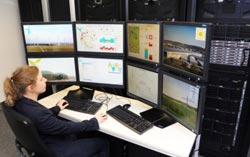Renewable Sources Can Provide Stable Power

<br>
Nevertheless, experts are still deliberating which market model is best for transitioning to renewables.
However, one of the major technological challenges in this regard, namely balancing the fluctuations that are caused by wind and solar power, may soon be solved. The research project Kombikraftwerk 2 (Combined Power Plant 2) shows that a Germany-wide power grid could be stably operated even if it were fed only with electricity from renewable sources.
The project partners (which included Siemens' global research unit Corporate Technology) also demonstrated that solar, wind, and biogas power plants can contribute to system stability if they are connected with one another to form an intelligently controlled power plant.
In addition to wind, solar, biogas, and geothermal facilities, hydroelectric plants, pumped-storage electrical power stations and power-to-gas facilities also played a key role in the project scenario. Surplus electricity was used for the electrolytic generation of hydrogen, which was combined with CO2 that had been separated from the exhaust of fossil fuel power plants to form methane and then fed into the public gas network.
Gas-fired power plants used this methane to generate electricity whenever bottlenecks arose. On the basis of weather data and electricity consumption data, the simulations calculated the power output and the demand for every hour of the year in great detail and determined how electricity had to be transmitted in the grid.
Grid frequency and voltage must be kept stable in order to prevent power outages. As a result, power plants must provide a certain amount of reactive and controlling power. To maintain such power reserves in the scenario, the settings of the wind power rotors were adjusted to reduce output and the inverters that feed electricity into the grid were used to limit the power generation of the photovoltaic facilities. The simulations and the field test showed that a combined power plant consisting of renewables, gas turbines, and storage systems can provide the required level of output within seconds.
Experts at Siemens Corporate Technology made optimization calculations for the economical construction of electrolysis facilities and methane power plants. They also determined how much the grid would have to be expanded. Moreover, they calculated the power flows in the grid for every instant and every location, and they worked together with the University of Hanover to determine how much reactive and controlling power would be needed. In this way they showed in detail how system stability can be maintained at all times throughout the year.
Besides Siemens, the partners in the three-year Kombikraftwerk 2 research project were the German Meteorological Service, Enercon, the Fraunhofer Institute for Wind Energy and Energy System Technology (IWES), Ökobit, Leibniz University in Hanover, SMA Solar Technology, SolarWorld, and the German Renewable Energies Agency.
Media Contact
More Information:
http://www.siemens.com/innovationnewsAll latest news from the category: Studies and Analyses
innovations-report maintains a wealth of in-depth studies and analyses from a variety of subject areas including business and finance, medicine and pharmacology, ecology and the environment, energy, communications and media, transportation, work, family and leisure.
Newest articles

Nerve cells of blind mice retain their visual function
Nerve cells in the retina were analysed at TU Wien (Vienna) using microelectrodes. They show astonishingly stable behavior – good news for retina implants. The retina is often referred to…

State-wide center for quantum science
Karlsruhe Institute of Technology joins IQST as a new partner. The mission of IQST is to further our understanding of nature and develop innovative technologies based on quantum science by…

Newly designed nanomaterial
…shows promise as antimicrobial agent. Rice scientists develop nanocrystals that kill bacteria under visible light. Newly developed halide perovskite nanocrystals (HPNCs) show potential as antimicrobial agents that are stable, effective…



